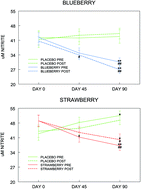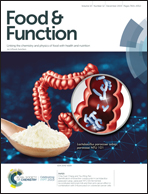The effects of blueberry and strawberry serum metabolites on age-related oxidative and inflammatory signaling in vitro†
Abstract
Berry fruits contain a variety of bioactive polyphenolic compounds that exhibit potent antioxidant and anti-inflammatory activities. We have shown that consumption of freeze-dried whole berry powder, equivalent to 1 cup per day of blueberry (BB) or 2 cups per day of strawberry (SB), can differentially improve some aspects of cognition in healthy, older adults, compared to placebo-supplemented controls. We investigated whether fasting and postprandial serum from BB- or SB-supplemented older adults (60–75 years), taken at baseline or after 45 or 90 days of supplementation, would reduce the production of inflammatory and oxidative stress markers compared to serum from a placebo group, in LPS-stressed HAPI rat microglial cells, in vitro. Serum from both BB- and SB-supplemented participants reduced nitrite production, iNOS and COX-2 expression, and TNF-alpha release relative to serum from placebo controls (p < 0.05). Protection was greatest with serum from the 90-day time-point, suggesting that ongoing supplementation may provide the most health benefits. Serum was protective in both fasted and postprandial conditions, indicating that the effects are not only acute and that the meal did not challenge subjects’ ability to regulate oxidative and inflammatory stress. These results suggest that berry metabolites, present in the circulating blood following ingestion, may be mediating the anti-inflammatory effects of dietary berry fruit.

- This article is part of the themed collection: Berry Health Benefits Symposium


 Please wait while we load your content...
Please wait while we load your content...
